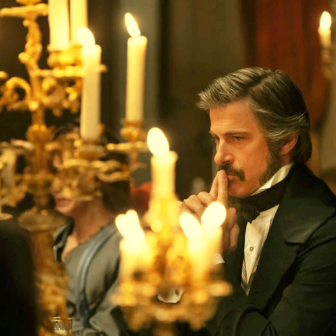What is it about Jane Austen? As with Dickens or the Brontës, say, the huge number of film and television versions makes her reputation secure — even if recent audiences have given up reading the books. IMDb tells us there have now been seventy-seven adaptations of Austen’s work, the latest of which, released here last month, is Working Title’s Emma. This is merely the eighth rejigging of the story of its manipulative eponym in one or other audiovisual medium. Which raises the question: does this Emma bring anything new to our perspective on Austen’s dealings with her?
To start with what may seem a trivial matter. Some decades ago, when I was writing about the silent film version of Nathaniel Hawthorne’s The Scarlet Letter, a female colleague took issue with the underclothes the heroine was wearing, claiming women never wore pants in the period of the film’s setting. In the latest version of Emma, Austen’s protagonist (played by Anya Taylor-Joy) is seen standing in front of a fire and lifting her skirts to warm her bare bottom. A little earlier there had been a naked rear view of Mr Knightley (Johnny Flynn) as he was being dressed in every detail by a manservant.
The point I am making about Autumn de Wilde’s film, directed from Eleanor Catton’s screenplay, is that it is concerned to establish a sense of historical period through such seemingly small details: the absence of Emma’s item of lingerie clearly signifies a now-distant past, and the fact that Knightley requires such sartorial attention immediately illuminates the class lacunae at the heart of Austen’s world.
In such details, and in the titles that announce the changing seasons, the filmmakers have set out to make something new from the classic novel. The most interesting adaptations are those that shun a reverential approach to the text by offering a different slant on something we already knew. In this new film, other matters, such as an intermittently choral-sounding musical score or the crocodile line of red-cloaked schoolgirls making their way about the village and its surrounds, also subtly enrich the texture of this small world.
Having failed so far to answer my opening question, perhaps what I really mean is this: what is it about Austen’s novels that so persistently attracts filmmakers’ attention? Well, they are undeniably witty in tracing their characters’ path to marriage, and along the way they are perceptive about what makes people behave as they do and how matters such as wealth and class help to account for this.
Austen is very rigorous in her dealings with such matters; there is not an atom of sentimentality in her novels, and Emma may well be the most demanding of them. Some readers even find it the least likeable, with its heroine so sure she is always right in her interference in the lives of those around her. Only very near the end is she brought to realise that there is more to life than merely getting her own way.
How does de Wilde, whose previous career was largely in video shorts, deal with the fact that Austen’s original five-volume novel ran to nearly 500 pages? The film begins with the novel’s opening sentence — “Emma Woodhouse, handsome, clever, and rich…” — quoted over images of its heroine sleeping and then, choosing roses in the garden, imperiously directing the servant, “Not that one. The next.” Her way of dealing with her inferiors (and their name is legion, in her view) is quickly established, but it’s not all there is to her: the flowers are intended as a present to her governess, to whom she is devoted and who is about to make what Emma’s hypochondriac father names “an entirely unnecessary marriage.”
Having set Emma in place, physically and socially, the film preserves for the most part the novel’s central narrative trajectory, which is to bring her to a larger awareness of life. Along the way, de Wilde brings a necessary tough-mindedness to bear on Emma’s meddling, and she has been fortunate in Taylor-Joy’s subtle performance.
As is often the case with Austen, it is the arrival of newcomers that propels the plot. Emma takes under her wing Harriet Smith (very engagingly played by Mia Goth), “natural” daughter of someone unknown, which provides her with scope for her managerial talent — well, inclination anyway. Then there are the much talked-about Frank Churchill, who interests Emma, and Jane Fairfax, towards whom she has less than amiable feelings, and Reverend Elton’s new and absurdly uppity wife. There are also relationships with her dim and ageing father, the as-yet-unmarried vicar, and the incessantly gossiping Miss Bates.
The film has some difficulty in coping with the pairings and other connections that constitute this network of lives jostling for a place in the scene. Though both Callum Turner as Churchill and Amber Anderson as the musically gifted Jane Fairfax do attractively what is asked of them, there is really not enough for them to work with. The film might have been tightened if it had dispensed with them — their function in the plot is not made persuasive — and spent more time on the situation of Harriet and the young farmer Emma believes to be unworthy of her protégée.
But this is not a major quibble about a film that knows what it is up to in presenting a central figure who will be brought to more mature awareness. The camera adroitly picks out Emma’s response to a kind gesture on Knightley’s part when he invites the neglected Harriet to dance at a ball. And the Box Hill picnic at which Knightley makes Emma realise how much she has hurt Miss Bates is another step towards her emergence from her heedless girlhood.
If Taylor-Joy and Goth are the most interesting Emma and Harriet I can remember, there are at least two other wonderfully comic treats — from Bill Nighy as old Mr Woodhouse, repeatedly requiring screens to protect his knees from drafts, and from the towering Miranda Hart, whose Miss Bates also registers touchingly a brief moment of hurt. As well as the actors, other collaborators who make significant contributions to this latest foray into Austen are costume designer Alexandra Byrne and production designer Kave Quinn, both evoking time, place and character. As indeed does the film as a whole. •




